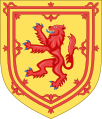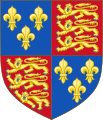User:Endrick Shellycoat/Sandbox2
| Royal coat of arms of the Kingdom of Scotland | |
|---|---|
James VI post 1603 | |
In My Defens God Me Defend (abbr. In Defens) | |
| Order(s) | The Most Ancient and Most Noble Order of the Thistle. (Arms feature the collar of the order) |
| Earlier version(s) |     |
| Use | Prior to the Union of the Crowns, 1603 |
The royal coat of arms of Scotland (also known as the Royal Arms of Scotland)
Prior to the 1707 Acts of Union the
Since 1603 the arms of Scottish and, since 1707,
Features
The pre-
Atop the shield sits the helm and crest. The helm is full-faced of demasked gold with six bars and features gold mantling lined with ermine. Upon the helm sits the crest, depicting the red lion, forward facing and sitting atop the Crown of Scotland, displaying the Honours of Scotland. (The lion wears the Crown of Scotland and holds both the Sceptre and the Sword of State).
Above the crest is the
The supporters are two crowned and chained
History
Kingdom of Scotland
A form of these arms was first used by
Throughout the ages the arms passed from monarch to succeeding monarch with only slight variations in detail. In some early examples the crest depicts the lion without a sceptre and holding the sword at an angle in the dexter paw, the sword blade passing behind the crowned head of the lion. Other versions show the unicorn supporters without their crowns, although being considered dangerous beasts they are always chained.
The motto In My Defens God Me Defend also appears as In My Defens or simply In Defens, whilst always appearing above the crest in keeping with the conventions of Scots heraldry. The lions, both rampant and sejant affronte, are usually depicted with blue tongue and claws, in heraldic terms armed and langued azure, but this has not always been the case. The tail of the lion rampant often ends by falling away from the back of the animal but at times is depicted turning inwards towards the head. The lion rampant has even been depicted on a banner wearing a crown in the style of the Norwegian coat of Arms.
Many of these relatively minor variations will have resulted from the individual efforts of stonemasons, weavers, artists and sculptors throughout the ages in their attempts to create a facsimile of the arms of the period.
In 1672 Charles II registered the blazon of the achievement of the Kingdom of Scotland as follows:
Or, a Lyon rampant gules armed and langued azure within a double tressur flowered and counter-flowered with flowers de lis of the second, Encircled with the order of Scotland the same being composed of Rue and thistles having the Image of St. Andrew with his cross on his brest yr unto pendent Above the shield ane Helment answerable to his Majesties high qualitie and jurisdiction with a mantle or doubled ermine adorned with ane Imperiall Crowne beautified with crosses pattee and flowers de lis surmounted on the top for his Majesties Crest of a Lyon sejant full faced gules crowned or holding in his dexter paw a naked sword proper and in the sinister both erected paleways supported be two Uniccornes Argent crowned with Imperiall and goarged with open Crownes, to the last chains affixed passing betwixt their fore leggs and reflexed over their backs or, he on the dexter imbracing and bearing up a banner of cloath of gold charged with the Royall Armes of Scotland and he on the sinister another Banner azure charged with a St Andrews Crosse argent, both standing on ane compartment placed underneath from which issue thistles one towards each side of the escutcheon, and for his Majisties Royall Motto's in ane escroll overall In defence, and under on the table of the compartment Nemo me impune Lacessit.[2]
Kingdom of France
When
Following the death of Francis in 1560, Mary continued to use the arms showing Scotland and France impaled, (with a minor alteration of the arms to reflect her change of status from queen-consort to
Kingdom of England and Kingdom of Ireland (Union of the Crowns)
On the death of Queen Elizabeth I of England in 1603,
During the reign of
The addition by King Charles of Nemo me impune lacessit ensured that the
From the accession of the
Changes to the blazon of the arms
- Following the marriage of Mary, Queen of Scots, in 1558, the blazon of the Royal coat of arms of the Kingdom of Scotland included elements from the arms of:
- The Dauphin of France, (1558–1559)
- The Kingdom of France, (1559–1565)
- Following the Union of the Crowns in 1603, the blazon of the Royal coat of arms of the Kingdom of Scotland included elements from the arms of:
- The Kingdom of France, (1603–1707)
- The Kingdom of England, (1603–1707)
- The Kingdom of Ireland, (1603–1707)
- Following the reign of Charles II, King of Scots, the blazon of the Royal coat of arms of the Kingdom of Scotland included upon a blue scroll overlying the compartment, the motto of The Most Ancient and Most Noble Order of the Thistle; Nemo me impune lacessit, and elements from the arms of:
- The House of Orange-Nassau, (1689–1702)
- Following the Acts of Union of 1707, the blazon of the Royal coat of arms of the Kingdom of Great Britain used in Scotland included elements from the arms of:
- The Kingdom of France, (1707–1800)
- The Kingdom of Ireland (1707–1800)
- The Electorate of Hanover, (1714–1800)
- Following the Act of Union of 1800, the blazon of the Royal coat of Arms of the United Kingdom of Great Britain and Irelandused in Scotland included elements from the arms of:
- The Electorate of Hanover, (1801–1814)
- The Kingdom of Hanover, (1814–1837)
- Following the accession of Royal coat of arms of the United Kingdomused in Scotland were adopted.
-
Arms of the Kingdom of Scotland
-
Arms of the Dauphin of France
-
Arms of the Kingdom of France (Modern)
-
Arms of the Kingdom of England 1558–1603
-
Arms of the Kingdom of Ireland
-
Arms of the House of Orange-Nassau
-
Arms of the Kingdom of England (Modern)
-
Arms of the House of Hanover
Current uses
Despite the
Since 1603 the Royal coat of arms as they have appeared in Scotland have undergone numerous changes, however since 1837 the
Since the Union of the Crowns, these Scottish quarterings have been used for official purposes in Scotland, for example, on official buildings and official publications. The
The banner of the modern arms, the
The banner of the
The
Both the
The gold shield with double red tressure, with maple leaves (érablé-counter-érablé), is also used in the coat of arms of the Monarchist League of Canada, whose arms were granted by HM The Queen in 2002.
The Scottish arms also feature in the arms of the Lord Lyon King of Arms, the arms of the Royal Scottish Academy and those of the Royal Society of Edinburgh.
See also
- Honours of Scotland
- Kingdom of Great Britain
- Kingdom of Scotland
- Royal coat of arms of the United Kingdom
- Royal Standard of Scotland
- Royal Standard of the United Kingdom
- Scotland
- United Kingdom of Great Britain and Ireland
- United Kingdom of Great Britain and Northern Ireland
References
- ^ Royal
- ^ Fox-Davies, Charles, The Book of Public Arms (1915), p712
- ^ Coinage of Great Britain. Celtic to Decimalisation, by Ken Elks. Part 12, Scottish Coins.
- ^ Scottish Coins ~ Mary (1542–1567)
- ^ Public Sculpture of Glasgow by Ray McKenzie, Gary Nisbet
- ^ British Monarchy web site
- ISBN 0-9525258-2-8)
Scotland Scotland Category:National symbols of Scotland Category:Scottish monarchy









